Get started on your journey to living in a home that feels comfortable and welcoming.
Here are the 5 steps to efficient cleaning:

Some people may hang onto excess items or animals that can compromise the health and
safety of the home. It’s important to keep up on cleaning and pay close attention to your common trouble spots so your home can remain safe and healthy. Common categories that stack up easily include:
Are you holding onto books you’ll never get to? Do you have stacks of books you will probably never open again?
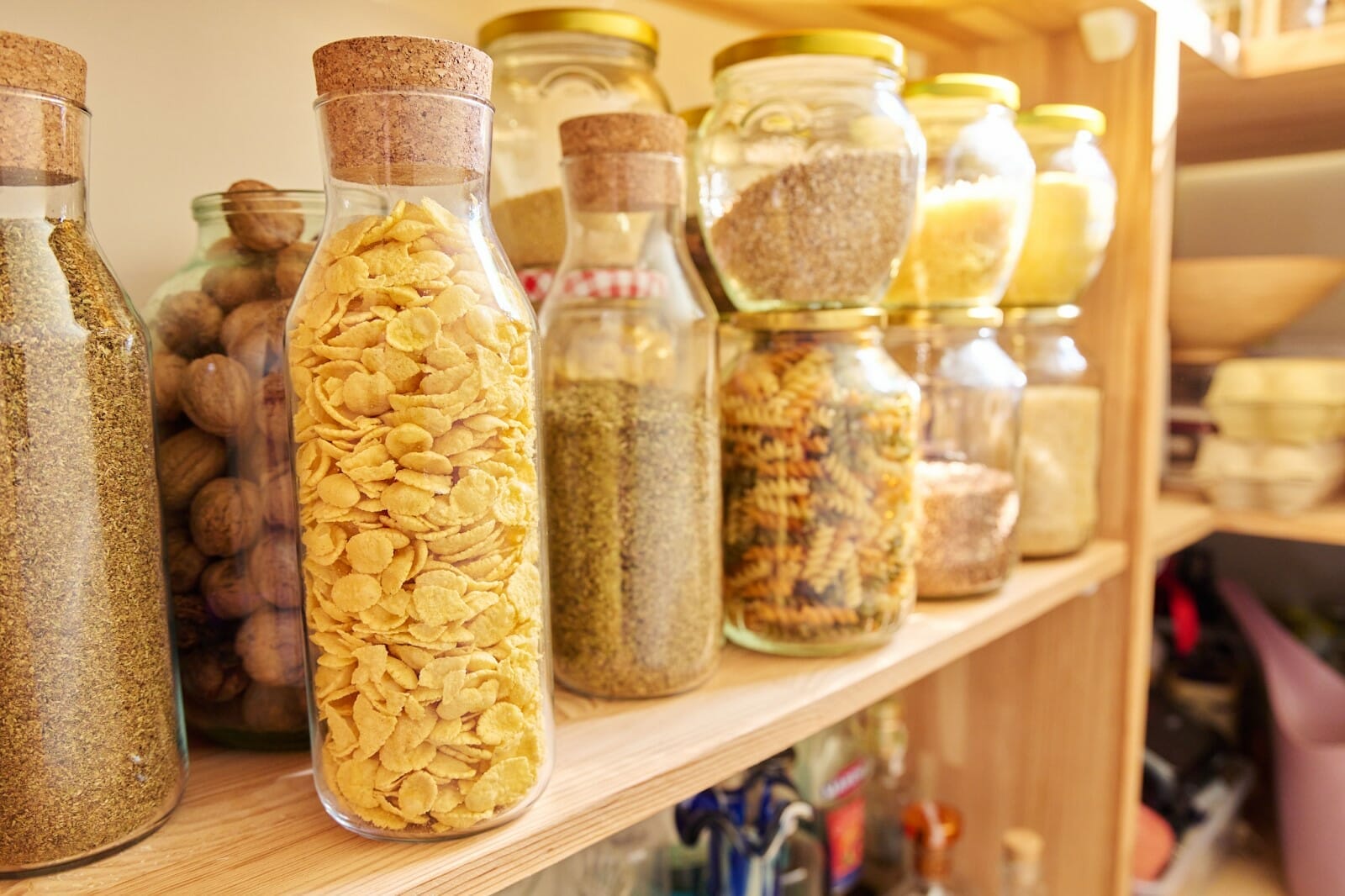
Do you find yourself stocking up on certain foods, even if you can’t finish them before they expire? Are your cupboards filled with ingredients you don’t use?
Do you have stacks of old documents you don’t need anymore? Can you throw them away, or create a filing system for things you don’t have a digital record of?
Do you have items in your closet that still have the price tags attached? Do you find yourself buying and stowing things you don’t intend to use?

Do you have more animals in your home than you can care for? Sometimes people rescue animals out of compassion, but do not have the space or resources to care for all of them. If you struggle caring for your animals, you may want to evaluate your space and consider finding new homes for some of them.
Do you find yourself searching for free items left in others’ trash, or struggling to part with your garbage? Some people struggle to part with trash, whether their own or what they’ve found. However, trash can quickly create dangerous health situations by attracting pests.
Once you’ve identified what you want to change, it’s easy to get carried away with lofty plans. However, if you try to do too much at once, you can get overwhelmed and give up quickly.

Don’t expect to finish everything in one weekend. Remember, it’s a process!
Rather than saying you’ll finish the entire house by a certain date, give yourself smaller deadlines and plenty of space. If you’re not sure how long something will take, set a daily habit goal for yourself. You can set a timer for 5-15 minutes, returning to the same area each day until it’s finished.
Decluttering your home is a marathon, not a sprint! Don’t burn yourself out at the beginning. Keep it small, steady, and consistent.
Sometimes the hardest part of undertaking a big project is getting started! Get the momentum going by deciding what your first step will be.

Make it easier on yourself by picking a spot you can finish quickly. Accumulating some wins will help you feel good about your progress and strengthen your motivation and confidence.
Breaking your goals down into bite-size, achievable increments is a great strategy. Rather than saying “I’ll clean the bathroom first,” focus on decluttering the top drawer.
Once that is finished, pat yourself on the back and move on to the next drawer.
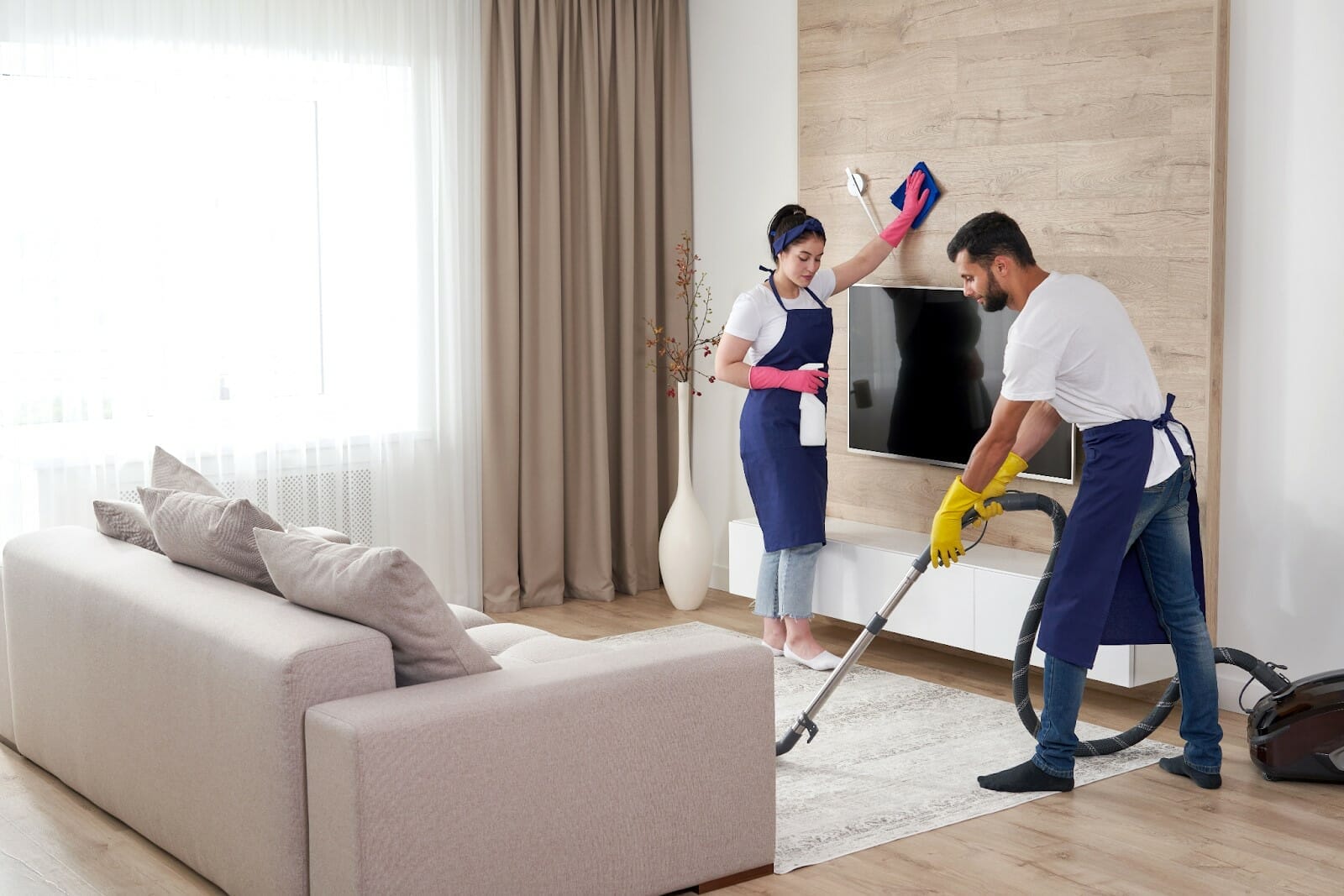
There are numerous decluttering strategies out there. Below, we’ve compiled what we found to be the most effective strategies for your use. Some will work for your personal strengths and needs, and others won’t.
Keep testing the cleaning methods listed below until you find something that resonates with YOU and helps you achieve your goals.
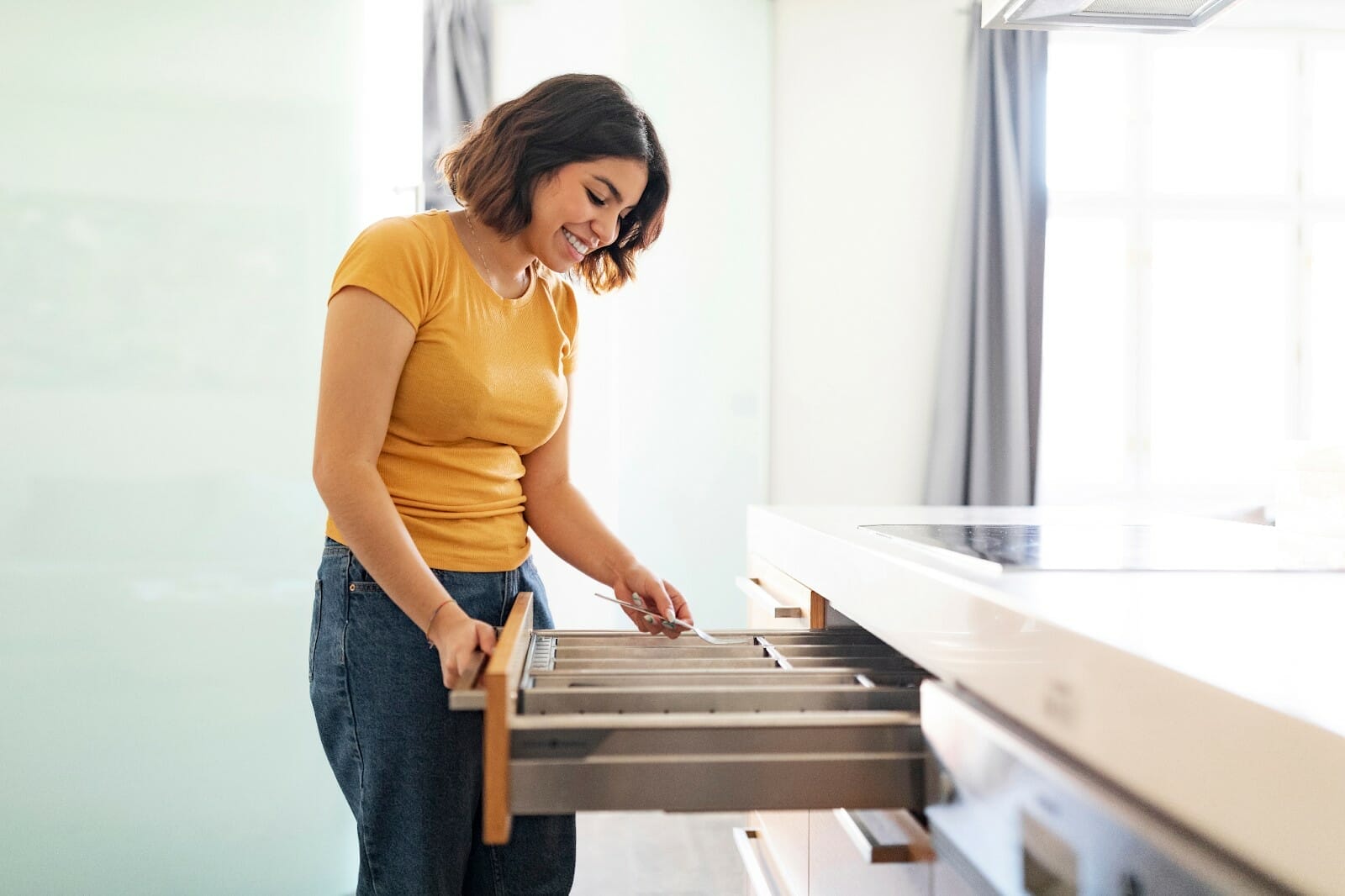
Each day, choose a drawer or other small space in your home and set a time for 5-15 minutes. Work on that space until your timer goes off, and then move on with your day!
Once you’ve finished a space, you can move on to the next area on your list.
The one-drawer-a-day method works especially well for people with ADHD or others who may quickly get distracted.
Sometimes, we hang onto things for years, thinking we’ll need them eventually. With this method, we introduce ways to track if items have been used in the last year. If not, they’re thrown out or donated.
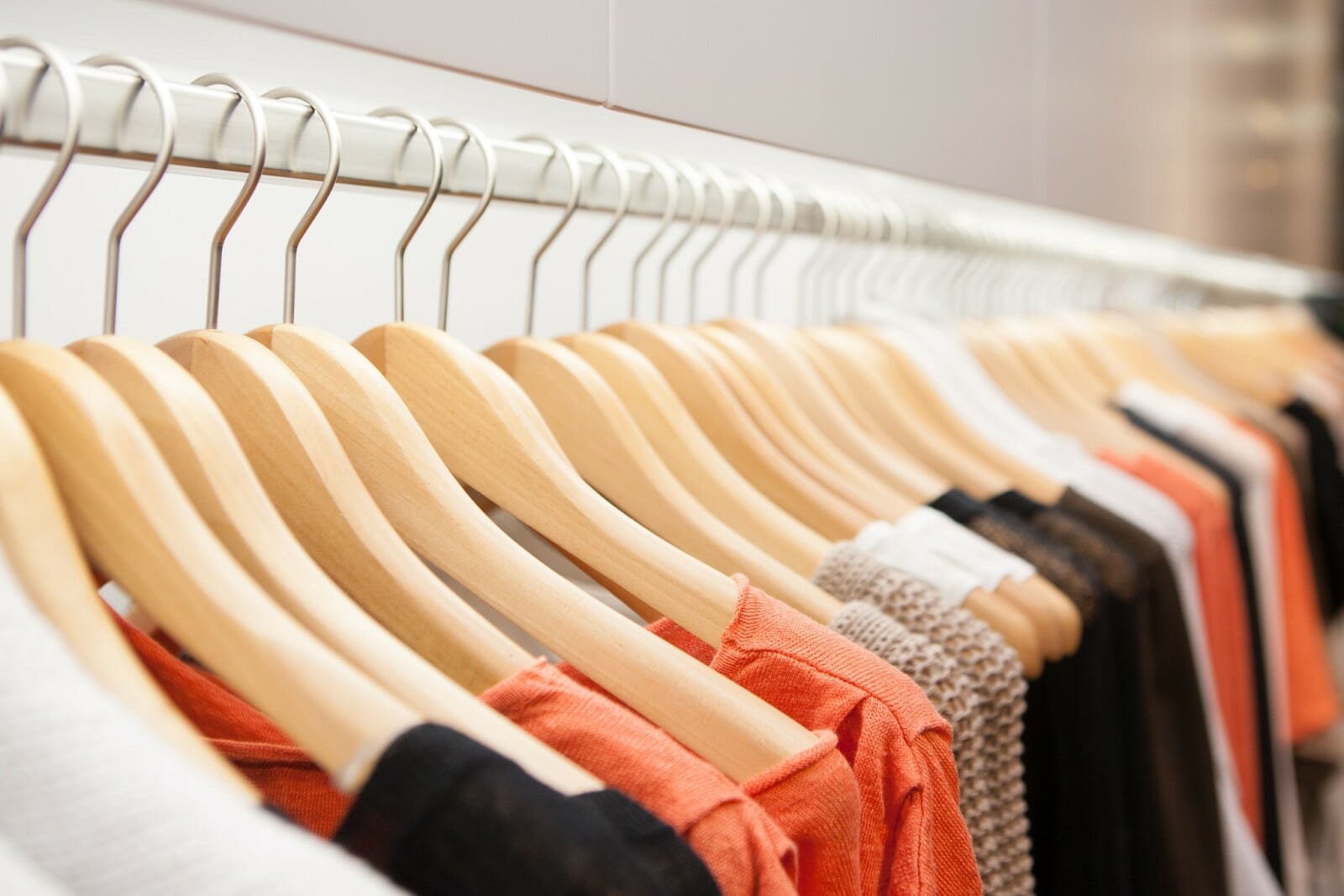
The next time you’re decluttering, ask yourself if you’ve used an item in the last year. If not, get rid of it.
If you’re sorting clothes, it can be helpful to turn all the hangers backward at the beginning of a season. Once you’ve worn something, you can hang it up the regular way.
Once that season is over, look through the closet and remove all the clothes still on backward-facing hangers—these are the pieces you wound up not using.
No matter how useful something is, having too much is unhelpful. If you have extras of something, donate them. Many organizations take extra items, and sometimes these donations are even tax-deductible.
These organizations are all good options to look into when donating extra items:

OHIO stands for Only Handle It Once. This method is particularly useful for mail and email. Don’t let things pile up. When you open your mail, you have three options:
Once you have a digital record of something, you can throw away the paper copy and know that you’ll never lose it.
Kondo’s method of decluttering involves asking yourself if different items “spark joy.” In her bestselling book, The Life-Changing Magic of Tidying Up, Kondo offers a unique process.
She advises going through your homes, touching each item you own, and asking yourself if it sparks joy. Often, she says, we are attached to our emotions and memories surrounding an object, and we don’t need the object itself to enjoy those emotions and memories.

While going through each individual item can feel overwhelming, as you make your way through the different spaces in your home, take an extra minute with the items that feel hard to part with.
Ask yourself if that item truly sparks joy. If you’re keeping it for any other reason (anxiety, guilt, fear), let it go.
One of the main premises of Swedish death cleaning is consideration for your loved ones who will need to deal with your belongings after your passing.
While it may seem morbid, in reality, choosing to downsize can lighten the burden for others in the future. Swedish death cleaning emphasizes taking your time and mindfully evaluating what you still need.
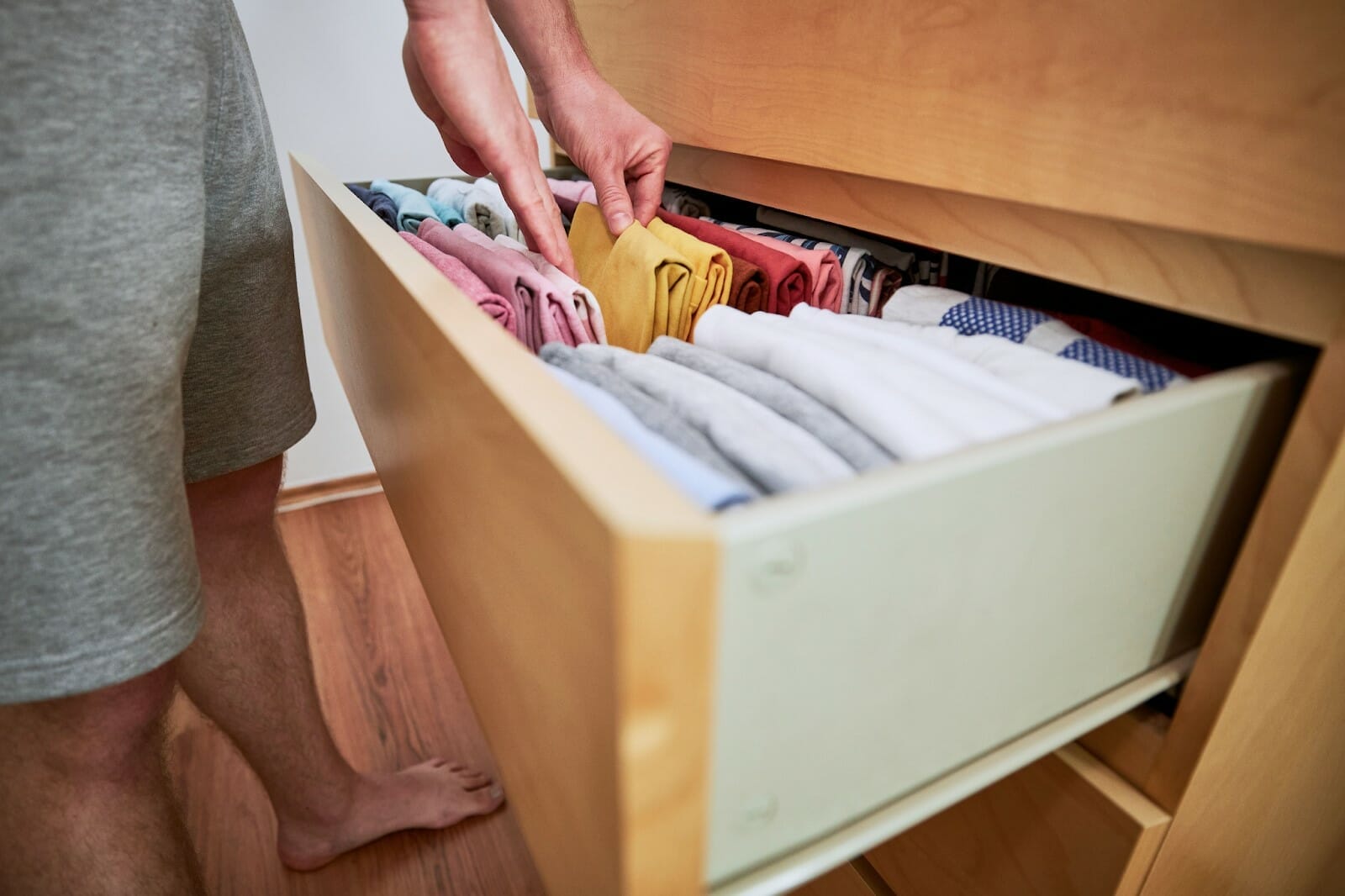
For the 4-box technique, label four different boxes with:
If you’re keeping it, put it in the keep box.
If you don’t need it but it’s still in good shape, put it in the donation box.
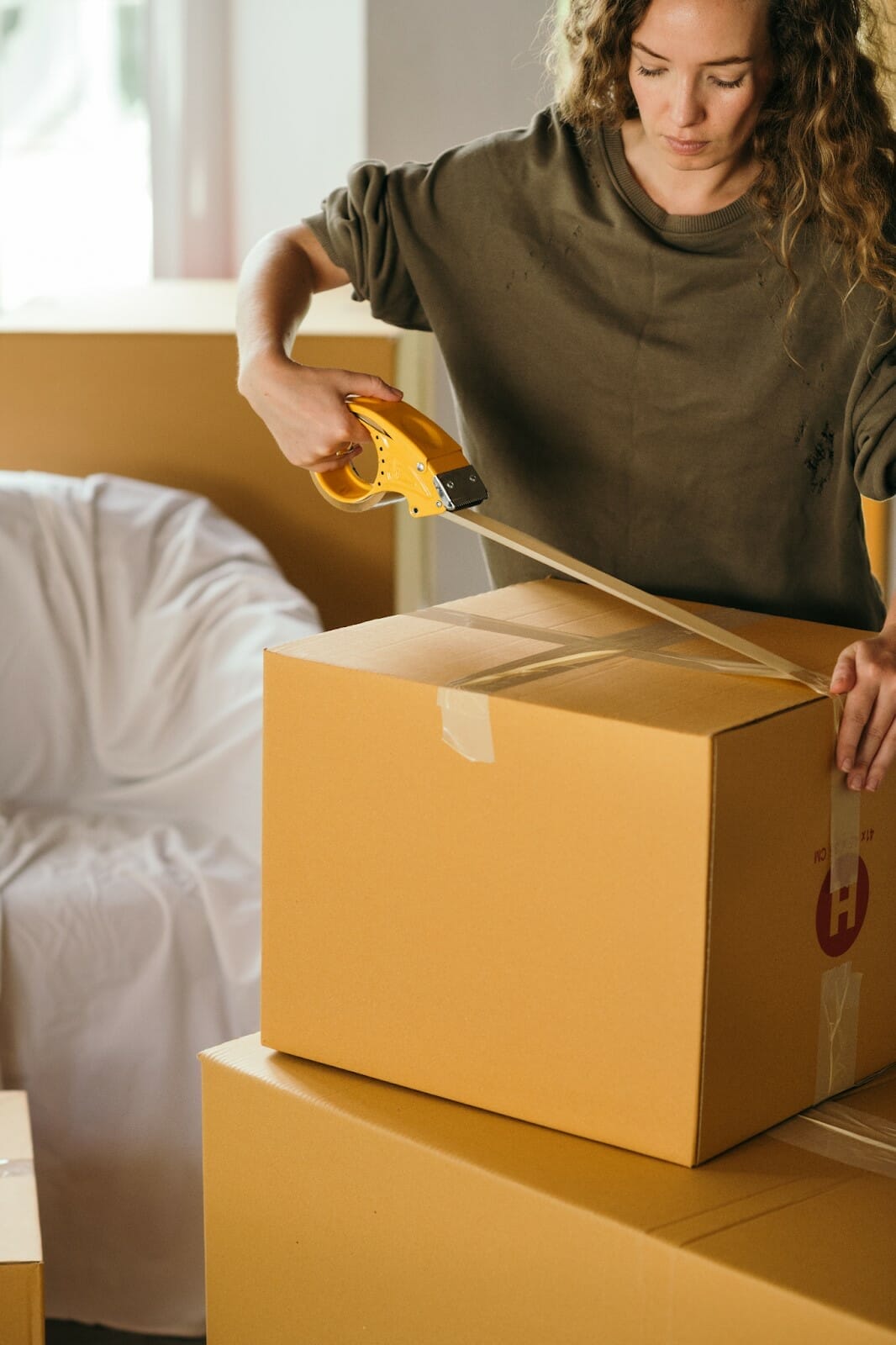
If you don’t need it and it isn’t in good condition to donate, put it in the trash box.
If you need it in a certain season, but not this current season (think baby gear if you’re planning on having another child, seasonal decor, winter clothing, etc.), put it in the store box.
With your four boxes, move to the first space you want to declutter and put items in the appropriate box. Once you’re finished with a space, empty the boxes before you move to the next space. Put away the keep items, throw out the trash items, and so on.
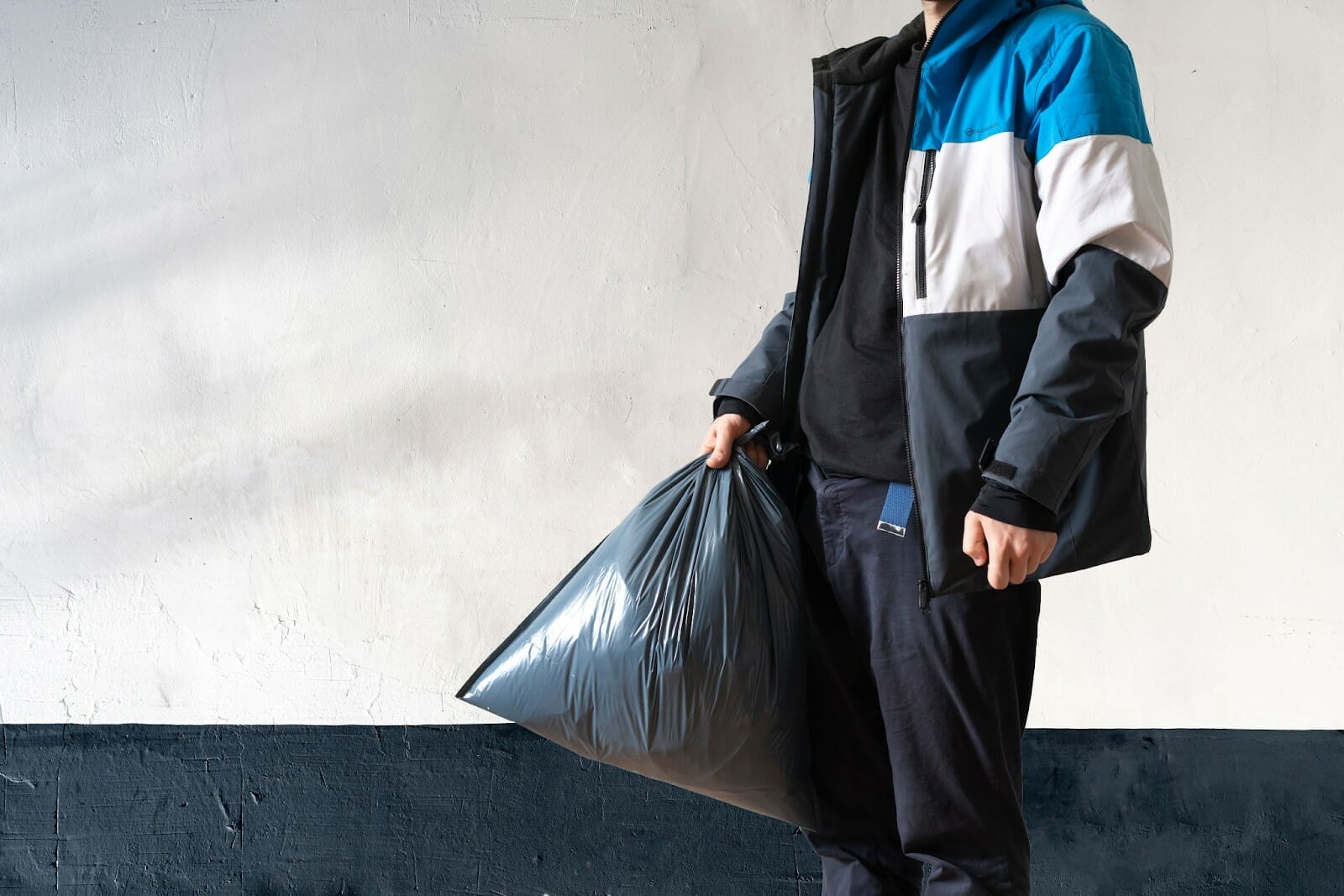
For a motivating win to get your sense of accomplishment up, do a quick 21-item toss.
Grab a trash bag and walk through your house, picking up the first 21 things you see that you don’t need anymore and throwing them away. If you make this a habit, you can quickly clear out things you no longer need and make a big difference in your space.
It’s a great excuse to get up from your desk for a few minutes or fill the time during a commercial break. You can enlist your kids or partner to help too—or race to see who can toss 21 items first!
If you’re saving something for a rainy day, put it on a firm deadline. Box up the items you think you’ll need someday and write an expiration date on the outside of the box.
If you haven’t gone looking for the items by that date, simply donate or throw away the box. Put a reminder in your phone or calendar so you don’t leave the box gathering dust in your garage for years.
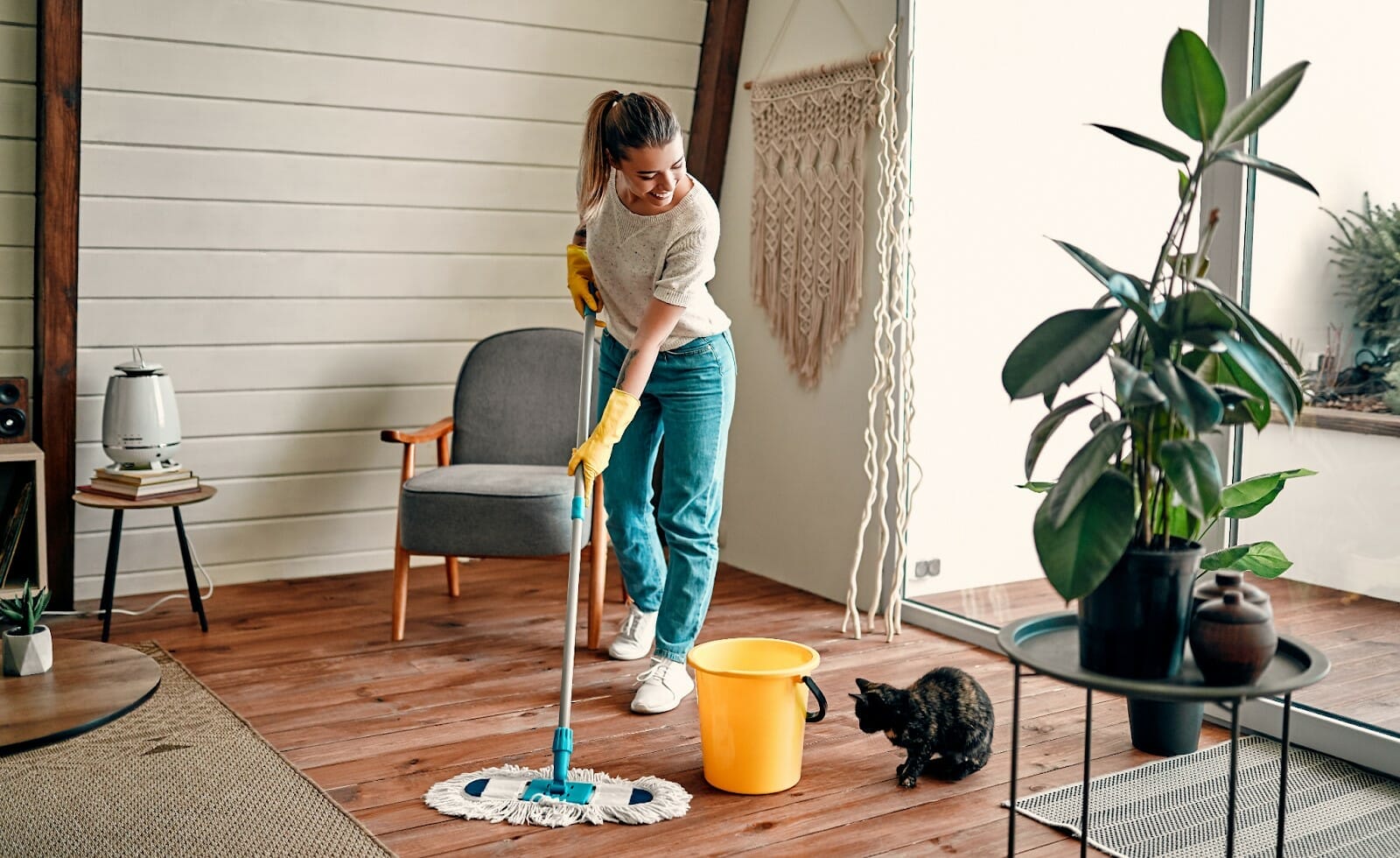
For a week-long challenge, choose 7 manageable areas you want to tackle. Each day for a week, clean one of your zones. Make sure these areas are small so you don’t get overwhelmed—you want to set yourself up to win by picking things that can be accomplished in a day!
Sometimes we need to make a few purchases in order to organize our homes. It makes it even harder to clean things up if you’re dealing with:
Finding a storage bin, new hangers, or another organizer to corral these items can make all the difference. But beware, don’t let shopping for organizational solutions become a new way to clutter up your home.
Recognize that if you are constantly buying new bookshelves or storage bins, it’s probably time to go through your items and get rid of some of them.
Getting rid of things can be a painful process, but understanding your reasons for decluttering increases your motivation. Ask yourself these 12 questions to decide if something deserves a spot in your home:

We are delighted to announce our sponsorship of the First Responder Relay in Las Vegas on October 16th. The First Responders Relay is a 9 person 48-mile running relay with stages ranging from 4.0 miles to 7.7 miles. The relay is competition comprised of first responder personnel from throughout the United States and the World, and is hosted by the California Police Athletic Federation (CPAF).
There is still time to register, but don't delay! Registration closes September 18. Visit www.CPAF.org to join us in Las Vegas!
Losing a loved one in an accident is incomprehensibly painful. The seeming unfairness and randomness of the moment is almost impossible to accept at first as grieving friends and family members try to rationalize what happened. They often feel guilty for not doing enough to prevent the death despite the fact that the incident was entirely out of their control. But nobody can prepare for the sudden and unexpected. Accidental deaths are by definition unnatural and unintentional. They include slips and falls, traffic accidents, poisonings, accidental weapon wounds, drownings, fire injuries, head traumas, industrial accidents, choking deaths, explosions, and natural disasters. Fatal accidents have always been a leading cause of death in America. But unfortunately, they are becoming more common.
According to the non-profit National Safety Council, accidental deaths increased 96 percent over the last 25 years. Though they decreased significantly between 1950 and 1980, fatal accidents have been growing rapidly since the mid-1990s.Despite our innovation in creating safer technologies, today’s rate of 52.2 deaths per 100,000 people hasn’t been seen since the mid-1970s. Now, accidents are the number one leading cause of death for people aged 1 to 44, according to the most recent data from the Centers for Disease Control and Prevention. For all demographics, they are the third leading cause of death nationwide, with 169,936 deaths reported by the CDC in 2017.
While researchers have not reached a consensus on why accidental deaths are increasing, the NSC points to three trends to explain the rise, including increases in poisonings, motor vehicle deaths and falls among older adults. All of these injuries are preventable, they say, arguing on their website that institutions “have not consistently prioritized safety at work, at home and on the road”. Poisonings, the leading unintentional injury among CDC data, increased 11 percent between 2016 and 2017 . The NSC attributes the growth to the opioid crisis, which claimed the lives of 47,000 Americans in 2017 .
To put the CDC data into perspective, 466 people die from accidental injuries every day The number of friends and family members affected by the death of a loved one is even higher, resulting in an ever-growing community of people who must find ways to manage their grief. Bio-One works with these families every day to facilitate their steps towards recovery.
When fatal accidents happen, we dedicate our resources to helping families restore their home or business in a safe, private and efficient manner. Because first responders do not decontaminate crime scenes after they respond to a call, we step in to ensure that families are not exposed to disease and other dangers. Crime scenes harbor harmful bloodborne pathogens that contaminate the immediate area, leaving everyone on the property vulnerable to Hepatitis B, Hepatitis C and the Human Immunodeficiency Virus (HIV). Our licensed technicians use powerful, environmentally safe chemicals to thoroughly disinfect the area so you can rest assured that your family will be safe. We work with an appreciation for your valuables and will replace furnishings if need be. In hoarding situations, we remove clutter that may present a danger to other inhabitants, including feces and other biological waste.
When you give us a call at your local Bio-One office, we’ll immediately connect you with a representative that will address your unique situation. Because we value your time during this difficult moment, a team will be dispatched to your home or business within an hour to complete the service. When they arrive, they’ll come in unmarked vehicles to safeguard your privacy. Our team approaches their work with the sensitivity it demands and endeavors to address your needs with the compassion it deserves. Don’t hesitate to contact us if you have any questions. We are on standby 24/7/365.
We often forget about the people left behind in the wake of a homicide. News stories reveal who died but often fail to identify how their death impacts their loved ones. When someone is murdered, their family, friends and significant others endure one of the most traumatic experiences that anyone can face. These survivors are some of the least researched crime victims in America, and they are everywhere. According to the most recent FBI data, 16,214 Americans were murdered in 2018. For every one of those individuals an average of 7 to 10 relatives were severely impacted, according to an estimate by Lu Redmond, a homicide grief expert.
If the murder rate remains consistent, Redmond’s estimate means between 113,000 and 162,000 Americans will become homicide survivors each year. That’s in addition to the pool of survivors who already lost loved ones in previous years. Though the lack of research makes it impossible to quantify how many total homicide survivors there are in America, the number is high enough to warrant concern for how they are treated by health professionals.
For survivors, the grieving process is almost impossible to endure. Though loved ones will grieve in different ways depending on their relationship with the victim, the loss is shocking, unimaginable and absolute. They never had a chance to say goodbye to their loved one, and the plans they both shared will never come to fruition. This realization may be sudden. In some cases, it may take years. Some survivors find it difficult to accept a loved one’s death at first, resulting in a delayed reaction that is triggered by a situation that reminds them of the victim. According to the National Center of Victims of Crime, grief symptoms include shock, disbelief, numbness, changes in appetite and sleeping patterns, difficulty concentrating, anger, confusion, increased anxiety and fear. Financial loss, depression and family conflict are also common symptoms.
Discovering a murdered loved one in the home can trigger post traumatic stress disorder. After the first responders leave the scene, some survivors may feel compelled to clean up the aftermath themselves. Confused that the paramedics don’t complete this work, they may think the cleanup process is their responsibility and act immediately. After all, they want to restore the scene as quickly as possible. Operating in a state of shock, they’ll remove the blood stains, body tissue and contaminated materials from the home without recognizing the threat to their physical and mental health. In addition to exposing their body to dangerous bloodborne pathogens, survivors may experience traumatic flashbacks of the experience in the future and suffer from heightened anxiety and emotional numbness. These PTSD symptoms prolong the recovery process, making it even more difficult for survivors to cope with their new lives.
Bio-One works with communities across the nation to avoid this outcome. We employ certified technicians that respond to scenes of violent crime and clean up dangerous biohazards that pose a threat to you and your family. When we receive a request for our services, we’ll send a team to the job site within an hour to assess your situation and perform a comprehensive cleaning solution that restores the property. Our powerful, environmentally friendly chemicals eradicate harmful pathogens that spread Hepatitis B, Hepatitis C and HIV, giving you assurance that you will be safe long after the area is decontaminated. We’ll dispose of the infected materials that cannot be salvaged and replace flooring and other furnishings if we need to. Once the area is thoroughly cleaned, we’ll return it to its pre-incident state so you can focus on recovering.
We conduct this work because we want to help people who have been left to deal with a difficult, painful task. That’s why our company motto is “Help first, business second.” We don’t ask for payment until after the job is complete because we want to remove the safety threat from your home as quickly as you do. Every person on our team will arrive on-site with an understanding of the trauma you are going through and a respect for your privacy and personal needs. Contact your local Bio-One office today and we’ll immediately connect you with a representative that can assist you. We are available 24/7/365.
Although eight years have passed since the world’s top mental health experts classified hoarding as a unique compulsive disorder, the problem persists throughout the country. Researchers say that up to 20 million Americans suffer from this illness, which is described as an obsessive tendency to accumulate troves of objects with no practical value.Because hoarding is historically stigmatized and underdiagnosed, this number is likely a conservative estimate. Even more troubling, hoarding is expected to increase as the population ages and mortality rates rise. But the studies that dole out these numbers understandably focus on hoarders over other stakeholders in the community. Hoarders’ actions impact far more people than reflected in the data. Fires and collapsing structures caused by unstable hoarding situations jeopardize the safety of neighbors and government workers. Even animals suffer. According to the American Society for the Prevention of Cruelty to Animals, a quarter of a million animals are hoarded each year. But the people afflicted by the disorder’s worst consequences often live in the same household as the hoarder.
Families deteriorate as high levels of dysfunction, increased conflict and financial uncertainty hinder intimacy and devastate the emotional wellbeing of everyone in the home. Objects overwhelm the space and are guarded zealously by hoarders who are pathologically unable to discard anything they deem valuable. Hoarded items commonly include old newspapers, rotting food, cardboard boxes, pets, excessive piles of clothes and furniture that dominates the home. Space becomes constricted and practically unlivable, prompting hoarders to carve narrow passageways out of the clutter to navigate between rooms.
But despite the extreme measures’ hoarders take to endure these living conditions, the situation cannot be controlled. There is no space for shared activities among the family and no room to use necessary facilities like ovens, showers and beds. In fact, the concept of “space” alters entirely. Children may have to sleep on couches in the living room or in bed with parents to circumvent the clutter. Activities like eating, reading and sleeping are subject to the limitations of space and the normalcy of disorder.
The effect of living like this leads to feelings of isolation, depression and vulnerability. Confounded by the fact that the hoarding family member is usually controlling, stubborn and sensitive to criticism, other people in the home often feel undervalued and powerless. Any attempts to remove the clutter are met with fierce opposition and outrage by the hoarder, who suffers from severe distress when confronted with the notion of losing their valuables. Aware of these consequences, the family usually lives in isolation, refusing to invite friends and relatives over to the home out of embarrassment. These claustrophobic conditions extend to the mind, which is overwhelmed by feelings of frustration, helplessness and anxiety. Financial strains ensue as the hoarder spends money on items that have no discernable value to other family members. As the acquisition of objects greatly outweighs the removal of other objects, credit limits are reached and space disappears, leading to home maintenance fees, financial debt and increasingly frequent family altercations.
Onlooking children often find themselves torn between parents in these situations. Child protective services may be invoked at some point, breaking up the family and degrading the bond between child and parent even further. This possibility weighs heavily on the minds of older children, who often feel compelled to silence for fear that they will be relocated by the authorities. Child protective services are often justified in removing them from the home. Households governed by an extreme hoarder are vulnerable to disease, air pollutants, pests and fires. Children in these homes also face stunted social and cognitive growth as they endure harsh living conditions and parental strife. Moreover, research indicates that hoarding behaviors are learned and adopted by the children of hoarders, who may subsequently pass these tendencies down to their own kids.
The strains that hoarding places on families illustrates why reaching out for help is so important. If you or a loved one are affected by this destructive disorder, please contact Bio-One for assistance. We remediate homes affected by hoarding on a daily basis and can connect you with tools that can help. We are on standby 24/7/365.
Akron, Ohio, October 1st, 2019 – Bio-One Inc. has announced the opening of its newest office, in the Akron community. Bio-One offices provide top-notch decontamination and biohazard cleanup services while treating clients with the privacy and compassion which difficult moments demand. This location will serve the Akron area, and surrounding areas, as well as assist all other franchised locations.
Bio-One located in Akron is owned by lifelong Akron residents Babs and Cuyler Costanzo. After spending years in the corporate world, Babs and Cuyler chose to start Bio-One to become more involved in serving their community and helping families in their greatest time of need.
"This is quite an honor for us, to have Babs and Cuyler own an office in the Akron area. The fact that we found a local man and woman who have a passion to help their community gives us great pride at our corporate office that we have the right people owning an office in Akron,” said Jason OBrien, CEO of Bio-One Inc. “Having Babs and Cuyler aboard signals that our constant efforts towards business and service excellence are paying off. We are proud to include Babs and Cuyler and their Bio-One office in our Bio-One family. They exemplify our company motto of Help First, Business Second."
For more information on Bio-One in Akron, please call Babs and Cuyler at (330) 888-5665 or visit www.BioOneAkron.com.
“Bio-One is here to help and serve our community when those are in need”
About Bio-One Inc.
Bio-One Inc. is the first crime and trauma scene cleaning franchise, operating in 35 States with over 90 locations. Bio-One is committed to providing excellent service in recovery and suicide cleanup, homicide cleanup, hoarding situations, junk removal, deceased animal recovery, feces removal, pest and rodent droppings and much more. Each office is independently owned and operated by a member of the local community. For more information about Bio-One Inc., visit the Company’s website at www.bioonechicagonorthside.com or follow us on Facebook and Twitter.
SOURCE BIO-ONE INC.
CONTACTS:
Bio-One
Babs and Cuyler Costanzo
(330) 888-5665
Info@BioOneAkron.com
Bio-One Inc.
Jason OBrien CEO
720-463-3004
www.bioonechicagonorthside.com
Property managers adopt no-smoking rules for a reason. Strong odors diminish the market values for apartment units, homes, restaurants and office buildings. According to one estimate by the National Association of Realtors, homes lose 29 percent of their worth when they’re blemished by cigarette smoke .These properties may never sell, forcing landlords to invest in expensive restoration services to eliminate the odor and turn a profit. The Kennedy Restoration Company estimates that this process costs $15,000 for every 2-bedroom apartment unit in Portland, Oregon. A study approved by UCLA and supported by the California Department of Public Health came up with a more conservative estimate. They say that restoring multiunit apartments damaged by cigarette smoke in California will cost roughly $5,000 per unit on average. Though market values will differ depending on where you live, it’s fair to say that odor remediation services are almost always costly. They’re also time-consuming and laborious. Property managers lose money when they’re unable to rent out a unit and must find time in their day to conduct tedious research into restoration options that fit within their budget. Bio-One makes this process easy. We provide the most effective odor remediation service in the industry, and work with property managers daily to find an economical solution to their unique situations.
Odor restoration involves a comprehensive process that targets virtually every item in the building, including floorboards, drywall, ceiling panels and light fixtures. Technicians must ventilate the property, disinfect all surfaces and discard items that absorb and sustain the odor. That means carpeting must be uprooted, curtains must be replaced, and walls must be repainted with sealers that trap unpleasant aromas. Odors will return if this process is not conducted thoroughly, forcing remediation specialists to undergo an exhausting and meticulous cleaning procedure for every property they work on. The arduousness of these services explain why they are often so pricey. When you call your local Bio-One office for a service, we’ll give you a breakdown of total costs. But we do not require payment until after your property is restored.
Once you contact us, we’ll typically complete the job within a 24-hour window, giving you the quickest opportunity to place your property back on the market. Our process eliminates the possibility that odors will return, which often happens when people without the right training attempt to clean the space themselves. According to PBS, cigarette smoke pollutants linger on surfaces for up to five years. Because of the pervasiveness of these compounds, weak chemicals and superficial cleaning jobs simply mask odors for a couple of days. We’ll remove porous structures in the building that retain the odor, like carpeting and flooring, and use a powerful chemical solution to eradicate surface-level pollutants. Call us today and you’ll be connected to a representative who can address your situation. We are on standby 24/7/365.
If you hear fluttering, squeaking and other strange noises in the night, you likely have unwelcome guests living behind your walls. Bats are among the most troublesome. Because most species are endangered, federal law prevents you from harming or killing them. That means you cannot seal off entry points in your home while they are roosting inside. Doing so jeopardizes the safety of young bats who do not know how to fly. In lieu of starving to death, the adults will force themselves into your living space out of desperation, resulting in an unsettling experience for you and an often-fatal encounter for them. The complexities of removing them from your home make it easy to pass the problem off for another day. But you’ll want to act quickly. While bats are helpful to humans for controlling bug populations and stymieing the spread of the fatal mosquito borne Zika virus, they are dangerous. But not in the way you might think. Only about six percent of bats carry rabies, according to the Centers for Disease Control and Prevention, and they hardly ever attack people .The far greater risk to your health comes from guano—or bat excrement.
Guano are black, shiny pellets that crumble to the touch. You’ll find them directly underneath a roost and around entry points, and they’re usually accompanied by dark, muddy-looking urine stains. Because bats eat a third of their body weight in insects each day, they can produce voluminous heaps of excrement in just a couple of weeks. The size of the buildup depends on the number of bats in your home and the length of time they are unattended. In severe cases, these piles will grow several feet high. But if you have large masses of guano in your home, it will become apparent quickly. An overwhelming odor, distinct to bat guano, will emanate from the roost and attract other invasive pests, like cockroaches and beetles.
A few scattered pellets can be swept up without a problem. But when guano pile up, they become a culture medium for fungi. When unaware homeowners try to remove these crumbling heaps of feces, noxious spores that cause histoplasmosis—a life-threatening lung disease—are released into the air and inhaled. Fortunately, not everyone who contracts the disease will exhibit any symptoms. A strong immune system will usually kill the bacteria before a virus develops and the infected person will move on with their life not knowing that their body had been fighting a fungal disease. But people with weakened immune systems, like small children, the elderly and AIDS patients, are especially vulnerable. Early symptoms are closely associated with the flu. In two to three weeks, fever, chills, muscle pain and headaches will set in. But people who do not reach out for help may begin to exhibit alarming respiratory symptoms. Shortness of breath, fatigue and chest pain ensues, with the problem worsening until the lungs fail. Histoplasmosis can be treated effectively with prescribed anti-fungal medication if the infected person seeks a doctor quickly enough. But because of the health risk, homeowners are advised not to clean up guano themselves. Untrained and unwary cleaners will easily inhale spores while working in the narrow spaces that bats occupy. In some cases, they spread through the ventilation system and put everyone in the house at risk. Because of the size of the task, you’re better off hiring guano remediation specialists.
Bio-One has the equipment, the experience and the expertise to get the job done right. Our technicians will remove guano, urination stains and odors from your home for the most affordable price in the industry. We’ll also comprehensively disinfect the property to eliminate lingering bacterial threats. Contact us today and we’ll get the job done within a 24-hour window. Our offices never close.
Winston-Salem, NC Sept. 10, 2019 – Bio-One Inc. has announced the opening of its newest office, in the Winston-Salem, NC community. Bio-One offices provide top-notch decontamination and biohazard cleanup services while treating clients with the privacy and compassion which difficult moments demand. This location will serve Winston-Salem, the Piedmont Triad, and surrounding areas, as well as, assist all other franchised locations.
Bio-One Winston-Salem is owned by Nadine Black and Anthony Coleman. After spending years in the corporate world, Nadine and Anthony chose to start Bio-One to become more involved in serving their community and helping families in their greatest time of need.
"This is quite an honor for us, to have Nadine & Anthony own an office in the Winston-Salem area. The fact that we found Nadine & Anthony who have a passion to help their community, gives us great pride at our corporate office that we have the right people owning an office in Winston-Salem,” said Jason OBrien, CEO of Bio-One Inc. “Having Nadine & Anthony aboard signals that our constant efforts towards business and service excellence are paying off. We are proud to include Nadine & Anthony, and their Bio-One office in our Bio-One family. They exemplify our company motto of Help First, Business Second."
For more information on Bio-One in Winston-Salem, please call (336) 830-1336 or visit www.BioOneWinstonSalem.com
“Bio-One is here to help and serve our community when those are in need”
About Bio-One Inc.
Bio-One Inc. is the first crime and trauma scene cleaning franchise, operating in 35 States with over 90 locations. Bio-One is committed to providing excellent service in recovery and suicide cleanup, homicide cleanup, hoarding situations, junk removal, deceased animal recovery, feces removal, pest and rodent droppings and much more. Each office is independently owned and operated by a member of the local community. For more information about Bio-One Inc., visit the Company’s website at www.bioonechicagonorthside.com or follow us on Facebook and Twitter.
SOURCE BIO-ONE INC.
CONTACTS:
Bio-One Winston-Salem
Nadine Black
Anthony Coleman
(336) 830-1336
Bio-One Inc.
Jason OBrien, CEO and President
720-463-3004
www.bioonechicagonorthside.com
Police officers complete some of the most difficult tasks imaginable. Cleaning up biohazardous waste should not be one of them. Through their day-to-day activities, patrol officers regularly encounter bacterial threats at crime scenes. Blood, body fluids, narcotics and dangerous chemicals carry unseen pathogens that linger on surfaces for weeks. While officers do not interact with these substances like crime scene investigators or biohazard cleanup crews do, they frequently process suspected criminals and witnesses who may be contaminated. These biohazardous materials may be difficult to detect, especially in the chaotic aftermath of a crime scene. Traces of blood, saliva or fentanyl on someone’s clothes may not affect an officer directly, but bacterial agents stay on upholstery in patrol cars long after a suspect has been processed. Violence and unsanitary behavior by jail inmates creates the same problem for correctional officers. Letting these biohazardous materials fester in holding cells exacerbates the threat to authorities and prisoners alike. Trying to clean them without the right chemicals and equipment prolongs it. Both of these situations demand a comprehensive decontamination solution. Fortunately, Bio-One partners with local law enforcement to disinfect patrol cars and jail cells nationwide.
Each job that Bio-One completes is unique. But we’ve been in the business long enough to know that cleaning a vehicle is difficult no matter how much training you have. It’s cramped, restrictive and difficult to reach certain areas. Furthermore, porous materials in the vehicle soak up and retain bacteria long after they are exposed to chemicals and bodily substances, leaving officers and passengers vulnerable to infection. Unfortunately, materials saturated with bio-waste are difficult to clean with over-the-counter solutions. To diminish the risk of spreading disease through bloodborne pathogens, powerful chemicals are needed to disinfect the vehicle. We hire experts in biohazard remediation to thoroughly restore cruisers, transport vehicles, riot vans and K9 patrol cars so you don’t have to. We’ll dissemble and replace vehicle components that have been affected by biohazardous waste and target invisible pathogens that may have been left behind by a contaminated suspect. Our process also eliminates stubborn odors and removes signs of visible waste, like vomit or blood spills.
Bio-One will do the same for holding cells in jails and prisons, which can become hotbeds for infectious pathogens if proper deep cleaning techniques are not employed. Superbugs like MRSA and Escherichia are known to spread in confined spaces, especially where people share living quarters. A disease outbreak puts prisoners and correctional officers at risk and threatens the reputation of the entire facility. We’ll make sure that cells tarnished by vomiting, blood spills, urination, defecation and saliva are purged of pathogens. But we also handle suicide and homicide cleanup when they occur. We’ll remove materials affected by the incident and properly decontaminate the cell for future use.
Police work doesn’t need to be any more challenging than it already is. Contact Bio-One if you need to restore your patrol car or refurbish a holding cell in your facility, and we’ll remove the problem within a 24-hour window. We are on standby all night, every day of the year, to address your unique situation.